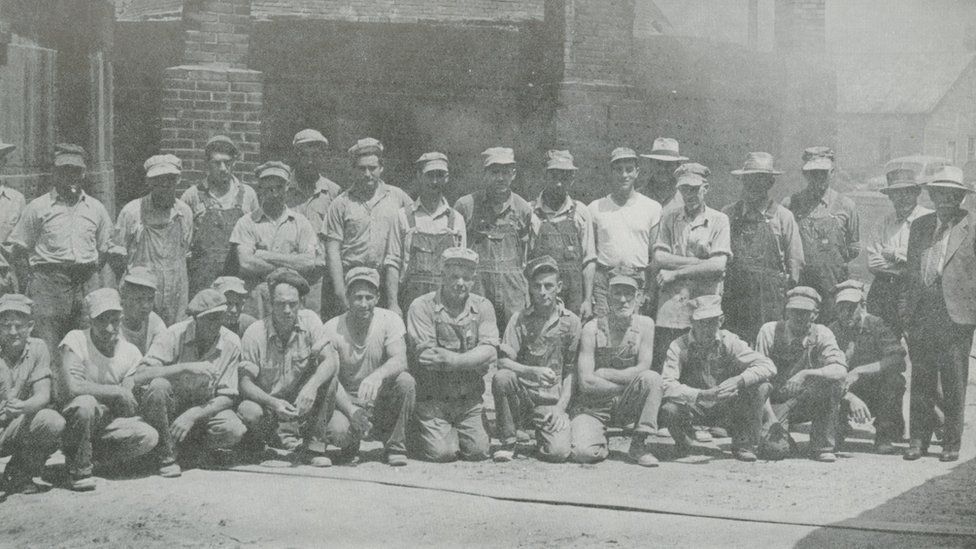Marking 200 years since Welsh settlers arrived in Ohio
- Published

Many times a group of friends have bemoaned their lives while sitting in the pub.
Few such conversations have ended in a resolution to up-sticks and travel to America, but that is precisely what six families in the village of Pennant, then Cardiganshire, did 200 years ago after a chat in the Ship Inn.
A total of 36 people left Aberaeron for Ohio in 1818, but by the end of the 19th Century there was a Welsh community there numbering close to 6,000 - including the ancestors of BBC newsreader Huw Edwards.
Today, it is thought there may be about 100,000 people in the state who can claim some Welsh descent.
Two centuries after they left, about 50 of them are expected back in Ceredigion to revisit their roots in a month of celebrations.
They start on Monday with the launch of Ohio and Beyond, a book chronicling the emigration, and continue throughout June with parties, a visit from a replica of the ship on which the 36 left for Liverpool on the first leg of their journey, and ending with a gala concert in the town's square.
BBC News presenter Huw Edwards has been to the pivotal state of Ohio, which could deliver the keys to the White House when the votes are counted on Tuesday night
Wales-Ohio organiser Ray Williams said: "It's been so much fun unearthing the stories of hope, disappointment, setbacks and success which forged a community.
"We launch the book at Siop Rhiannon, Tregaron, and we hope that will whet people's appetite for 18 celebrations.
"I'm particularly looking forward to the 70ft ketch, 'Keewaydin' berthing on the harbour wall outside the Harbourmaster hotel.
"Visitors will be able to take trips out into the bay and get a sense of what it must have been like for those who waved goodbye to Aberaeron 200 years ago."
Those who "waved goodbye" were fleeing religious and language persecution, high taxation following the Napoleonic Wars, a slump in agricultural prices and a population boom in west Wales.
Led by The Ship Inn's landlord John Jones Tirbach, they faced a daunting trip.
One little girl died en route before the group landed at Chesapeake Bay, Baltimore, where their travails began in earnest.
Travelling in wagons to Pittsburgh and then onwards by raft down the Ohio River, they intended to reach a pre-existing Welsh community in Cincinnati, 500 miles (800km) away.
Exhausted, they spent the night in Gallia County - where their rafts blew away in a storm - and from there they never moved.
They subsidised their living farming poor land by working on the highway between Chillicothe and Gallipolis.
From those harsh beginnings, Wales-Ohio project historian Arwel Jones explains the Welsh immigrants' luck was about to change.
"For a decade or more life was very tough and not many more followed the 36 to Ohio, then came the railways, and not long after, the civil war.
"The Welsh were hard workers, and used to iron, so they formed co-operative forges which made rails all over the US, and produced cannonballs for both the Unionists and the Confederates.
"That encouraged 3,000 or 4,000 more to leave Cardiganshire between 1830 and the end of the century, spawning success stories like Bob Evans, who established a very successful chain of drive-through restaurants which now have over 500 outlets, and the Davis Brothers' factories, making fire bricks for use in furnaces.
"Henry Ford was one of their customers and - ever thrifty - he'd insist on the bricks being delivered in wooden pallets, which were then broken up to make the floors of Model T Fords."
The immigrants would go on to form 25 Welsh-speaking chapels, with Welsh remaining Gallia County's most common second language until 1970.
To this day it is known locally as little Cardiganshire and boasts a Welsh Studies department at Rio Grande University.
When BBC presenter Edwards traced his Welsh ancestors in Gallia County in 2012, Mr Jones said it turned up one in particular who was quite a character.
"Perhaps the most successful of Huw Edwards' family were the Edwards Sisters - four sisters who travelled the length and breadth of North America singing as a quartet.
"Though by far the most colourful was Arthur Edwards who, at a fair in Ohio, volunteered to ride a hot air balloon sitting on a broom handle.
"He'd been given a parachute and told to jump off when the owner fired a gun, but he didn't hear it, and so clung on for dear life as the balloon carried him about 10 miles at a couple of thousand feet.
"He managed to survive unharmed, somehow."
- Published5 November 2012
- Published5 November 2012
- Published28 July 2015